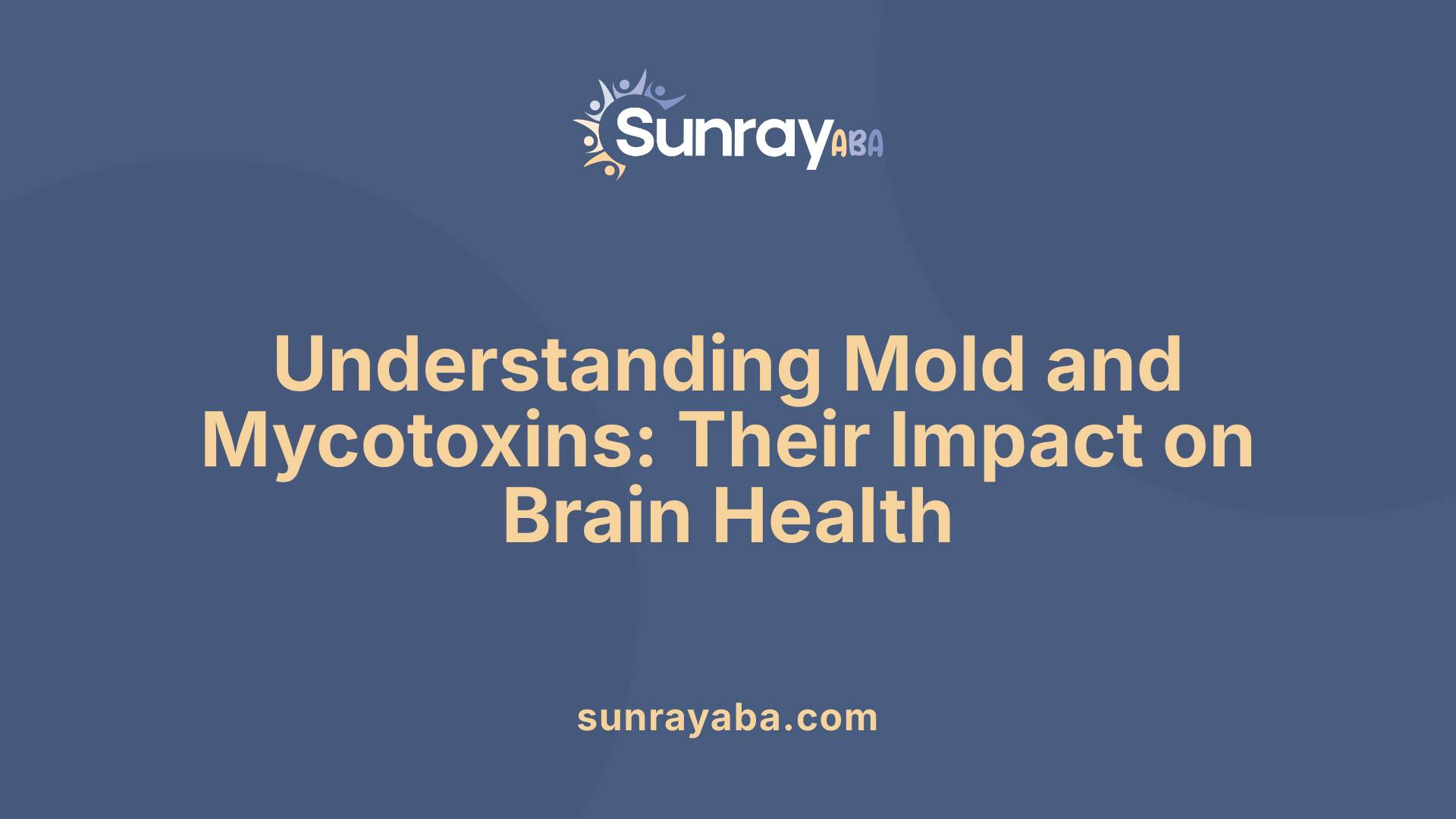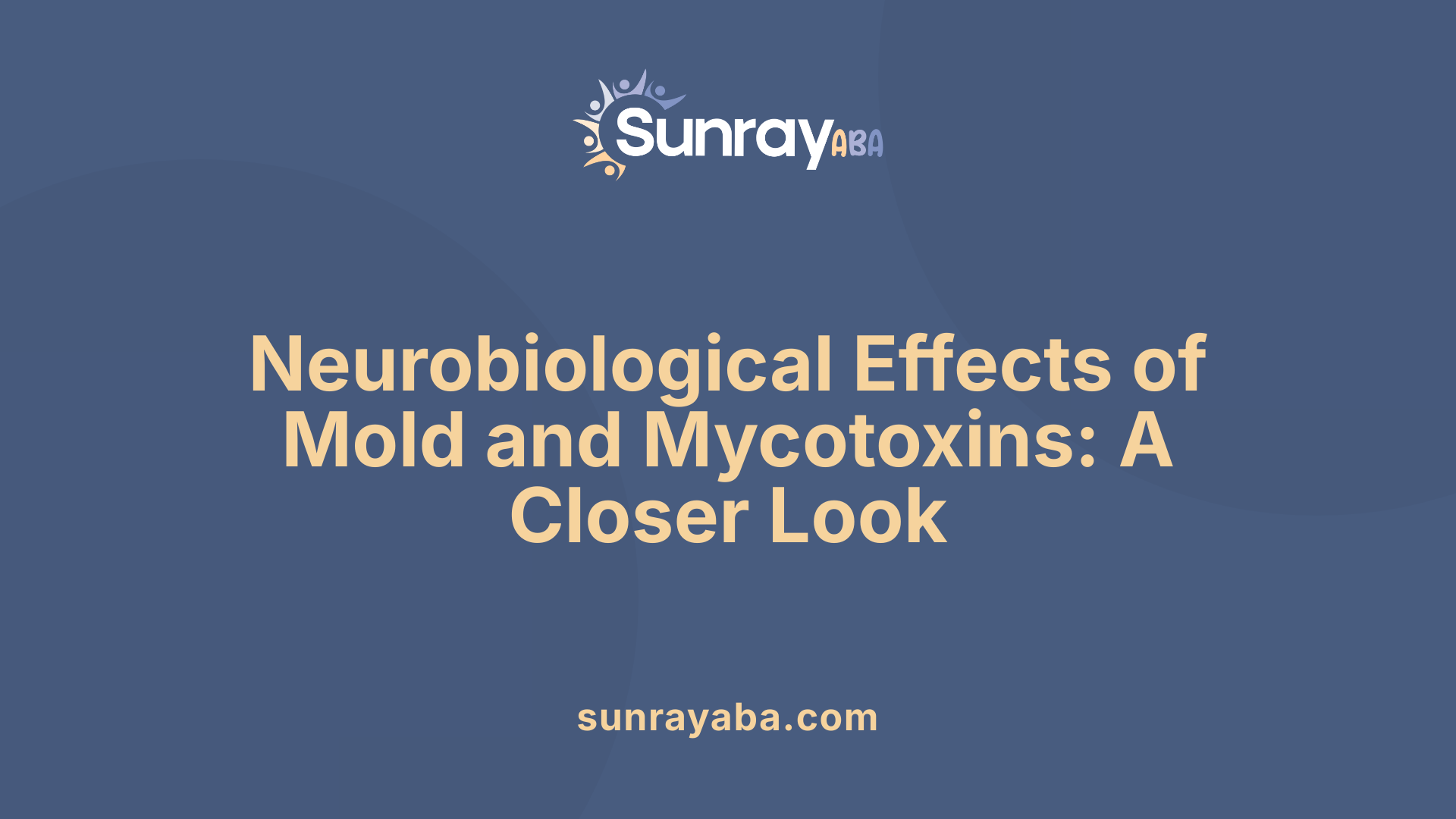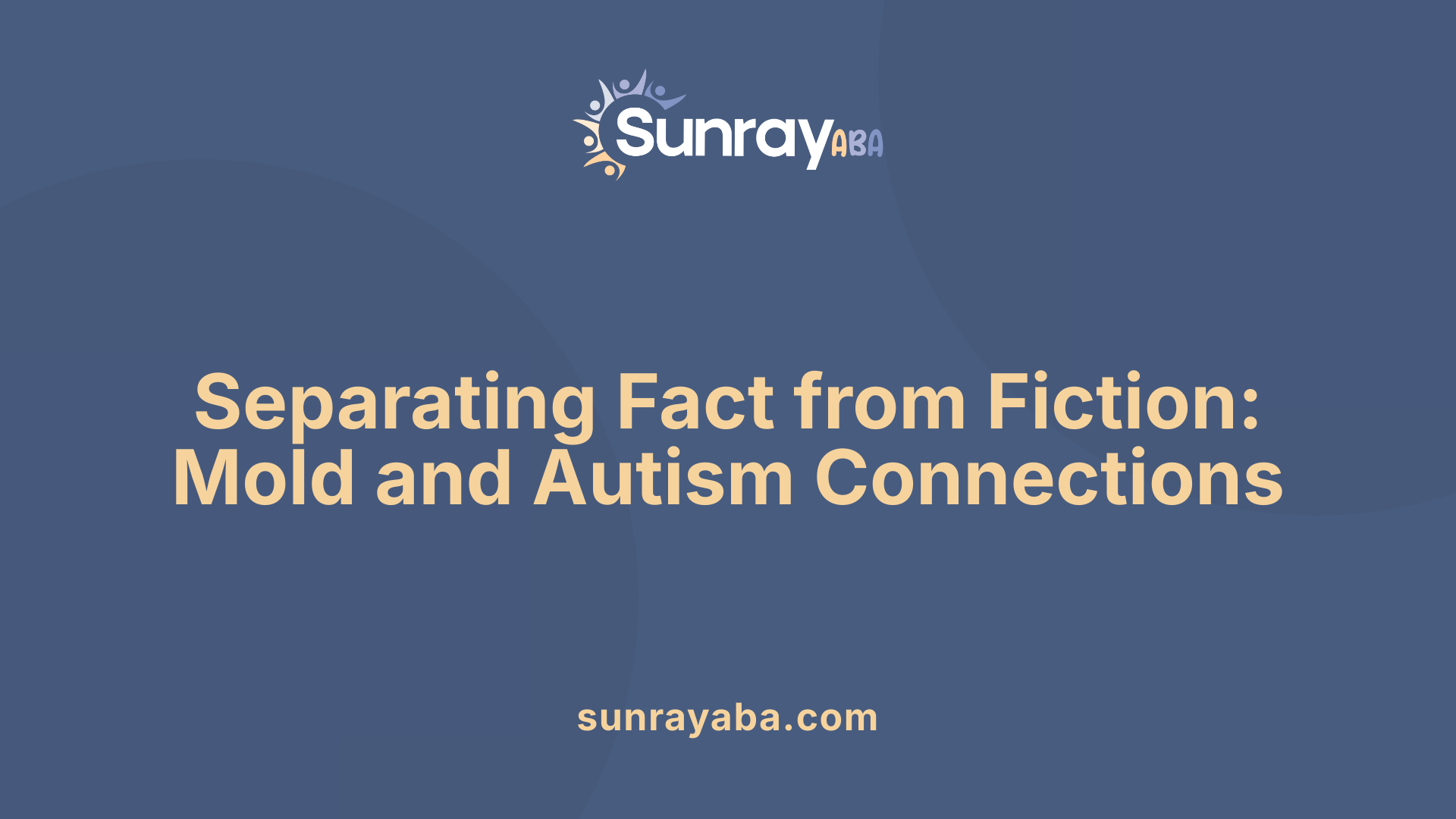Does Mold Cause Autism?

Understanding the Complex Relationship Between Environment and Neurodevelopment
Over recent years, discussions about environmental factors that may influence autism spectrum disorder (ASD) have gained prominence. Among these, mold exposure has been spotlighted, sparking curiosity and concern. This article aims to dissect the scientific understanding surrounding mold and its potential link to autism, emphasizing what the current research says, what misconceptions exist, and how environmental control can impact health outcomes.
Mold and Mycotoxins: An Overview of Their Nature and Health Effects

What are the health effects of mold and mycotoxins on brain function and neurodevelopment?
Exposure to mold and its toxic compounds, known as mycotoxins, can significantly impact brain health and development. These impacts occur both directly, as neurotoxins that affect neurons and brain tissues, and indirectly, by triggering immune responses that lead to neuroinflammation.
Certain mold species, such as Stachybotrys chartarum, Fusarium, Aspergillus, and Penicillium, produce a variety of mycotoxins including ochratoxin A, trichothecenes, and others. These toxic substances can enter the body through skin contact, inhalation of spores, or ingestion of contaminated food.
Once inside the body, mycotoxins can activate immune cells and stimulate the release of pro-inflammatory cytokines. This immune activation can lead to neuroinflammation, a process associated with impairments in neurogenesis, hippocampal function, and overall cognitive processes.
Animal studies provide evidence that mold exposure may cause deficits in memory, increased anxiety, and immune response activation within the brain. These findings suggest that mold-related toxins could negatively affect neurodevelopment, especially during critical growth periods.
In humans, there is a suggested link between mold exposure and neurodevelopmental disorders such as autism spectrum disorder (ASD). While research continues, systematic reviews indicate possible correlations but have not established a definitive cause-and-effect relationship. Some studies suggest that prenatal exposure to mold and mycotoxins might increase the risk of developing autism, emphasizing the importance of minimizing exposure, particularly during pregnancy.
Overall, the complex mechanisms by which mold and mycotoxins influence the nervous system involve inflammation, oxidative stress, and mitochondrial dysfunction, all of which have been associated with various neurodevelopmental challenges.
| Mold Species | Mycotoxins Produced | Potential Health Effects |
|---|---|---|
| Stachybotrys | Trichothecenes, Satratoxins | Neurotoxicity, immune activation, respiratory issues |
| Aspergillus | Aflatoxins, Ochratoxin A | Neurological symptoms, immune suppression |
| Penicillium | Citrinin, Mycophenolic acid | Allergic reactions, neurological disturbances |
| Fusarium | Trichothecenes, Fumonisins | Neurotoxicity, developmental disruptions |
These toxins can reach the nervous system causing systemic responses that impact the brain, immune system, and lungs. Emerging research indicates that mold exposure during early developmental windows can disrupt immune regulation and potentially contribute to neurodevelopmental disorders such as autism.
While the evidence is growing, ongoing studies aim to clarify the mechanisms and establish clearer causative links. Current findings suggest that reducing exposure to mold and mycotoxins could help improve behavioral and cognitive symptoms, especially in vulnerable populations like children with autism.
In summary, mold and mycotoxins pose significant risks to brain health, emphasizing the need for effective detection and mitigation strategies to protect developmental health during critical periods of growth.
The Scientific Landscape: Is There a Clear Link Between Mold and Autism?

Research findings from systematic reviews and studies
Recent systematic reviews and scientific studies have explored the potential connection between mold exposure and autism spectrum disorder (ASD). These comprehensive analyses, including reviews conducted in 2018 and 2021, delve into the role of mycotoxins—the toxic compounds produced by mold species such as Stachybotrys, Aspergillus, Penicillium, and Fusarium—and their influence on neurodevelopment.
Studies indicate that mycotoxins can affect the nervous system directly or through immune system activation. When inhaled, these toxins may lead to neuroinflammation, immune dysregulation, and neural dysfunction. Such effects are particularly concerning during critical developmental stages, where immune and neurological pathways are most vulnerable.
Research has shown that mold exposure can exacerbate neurological symptoms, including attention difficulties, concentration problems, and sensory processing issues, which are often observed in children with autism. Some experimental data suggest that mold and mycotoxins may impair cognitive functions and influence behavioral patterns.
Furthermore, evidence points to immune system modulation as a key pathway through which mold influences neurological health. Exposure to mold spores and toxins during pregnancy or early childhood might disrupt immune regulation and neurodevelopment, potentially increasing the risk of ASD.
Current scientific consensus
Despite the growing body of evidence suggesting a possible link, scientists emphasize that the relationship between mold exposure and autism is not yet fully established as causal. The current scientific consensus is that while mold and mycotoxins can have adverse neurological and immune effects, they are likely one of many environmental factors influencing autism development.
Comprehensive reviews have concluded that more research is required to definitively determine the extent of mold’s impact on autism. Larger, more controlled studies are necessary to clarify these associations and understand the precise mechanisms involved.
This cautious stance reflects the complex interplay of genetics, environment, and neurodevelopmental biology involved in ASD. Recognizing this, researchers continue to investigate how mold exposure might fit into the broader context of autism risk factors.
Ongoing investigations
Research continues in toxicology and neurotoxicology fields, exploring how mold and mycotoxins could influence neural pathways, immune activation, and inflammatory responses linked to autism. These investigations aim to establish more concrete causal links, investigate preventive measures, and develop potential therapeutic interventions.
In summary, current scientific findings and reviews suggest a potential association between mold exposure and autism, especially considering biological plausibility related to immune and neural mechanisms. However, a definitive causal link remains under investigation, with future research essential to clarify the relationship and inform public health policies.
| Aspect | Findings | Additional Details |
|---|---|---|
| Molds involved | Stachybotrys, Aspergillus, Penicillium, Fusarium | Producing harmful mycotoxins |
| Neurological effects | Attention issues, sensory processing, cognitive impairment | Impacted by neuroinflammation and neural pathway disruption |
| Immune response | Immune activation, inflammation | Contributing to neurodevelopmental disturbances |
| Research status | Suggestive but not conclusive | Larger, definitive studies underway |
| Prevention strategies | Moisture control, air filtration, mold remediation | Possible to reduce exposure and mitigate risks |
While there is compelling evidence pointing towards an association, the scientific community agrees that further research is needed to fully understand how mold and mycotoxins may influence the development of autism.
Environmental and Biological Factors in Autism Development

What background information is important to understand about autism causes and potential environmental contributors?
Autism spectrum disorder (ASD) is a complex neurodevelopmental condition with multiple potential causes. While genetic factors play a significant role, environmental influences are increasingly recognized as important in how autism develops.
Research shows that various prenatal and early-life exposures can impact neurodevelopment. For example, pregnant women exposed to air pollution, pesticides, and heavy metals such as lead and mercury may face increased risk of having a child with autism. Additionally, maternal health conditions, including obesity, diabetes, immune disorders, and episodes of fever during pregnancy, are linked to higher autism risk.
Birth complications, especially those involving oxygen deprivation or trauma, can also contribute to neurodevelopmental challenges. On the parental side, advanced ages of both mothers and fathers are associated with greater risks, possibly due to increased rates of genetic mutations and epigenetic alterations that affect fetal development.
Protective factors may help mitigate these risks. Adequate intake of folic acid and omega-3 fatty acids during pregnancy has been associated with lower chances of autism, highlighting the importance of nutritional and lifestyle interventions.
The biological mechanisms by which environmental factors may influence autism include processes like oxidative stress and inflammation, which can damage developing brain tissue. Endocrine disruption from certain chemicals further complicates this picture.
Specifically regarding mold exposure, recent studies suggest that mycotoxins produced by mold species such as Stachybotrys, Aspergillus, Penicillium, and Fusarium can affect neurological development. These toxins may activate immune responses and cause neural dysfunction, which are believed to contribute to autism symptoms. Exposure during critical periods of development, including prenatal stages and early childhood, might disrupt immune regulation and brain growth.
Emerging evidence links prenatal and early postnatal mold exposure with behavioral changes and neurological symptoms similar to or exacerbating autism. For example, mold releases mycotoxins that impact the nervous system directly or via immune activation, potentially leading to inflammation and neural pathways disruption involved in autism.
While research continues, systematic reviews from 2018 and 2021 suggest a possible connection between mycotocins from mold and autism, although a definitive causal relationship has yet to be established. These findings highlight the importance of understanding gene-environment interactions and underscore the need for further investigation.
Environmental and Biological Factors in Autism Development
| Factor | Impact | Explanation |
|---|---|---|
| Prenatal exposures | Increased risk of autism | Pesticides, air pollution, heavy metals during pregnancy |
| Parental age | Higher risk with advanced maternal/paternal age | Mutations and epigenetic changes |
| Birth complications | Hypoxia and trauma linked to neurodevelopmental issues | Oxygen deprivation, birth trauma |
| Maternal health conditions | Elevated risks including immune disorders, fever | Impact on fetal brain development |
| Nutritional factors | Protective effects of folic acid, omega-3 intake | Supports neurodevelopment |
| Mold exposure and mycotoxins | Possible neurological and immune effects | Toxins produced by mold species affecting nervous system |
| Gene-environment interactions | Complex influences with no single definitive cause | Ongoing research emphasizes their combined effects |
Understanding these multifaceted influences helps frame the complex origins of autism. It underscores that both genetic predispositions and environmental exposures, including poorly understood factors like mold mycotoxins, contribute to neurodevelopmental outcomes. Continued research in this area is essential to develop effective prevention and intervention strategies.
How Mold Fits Into the Broader Autism Puzzle

How does mold exposure relate to environmental and biological factors involved in autism?
Mold exposure is increasingly recognized as a possible environmental factor that can influence the development and severity of autism spectrum disorder (ASD). Mold produces mycotoxins, which are toxic compounds capable of affecting the nervous system directly or indirectly by triggering immune responses. When inhaled or come into contact with the skin, these toxins can induce inflammation, immune activation, and neuroinflammatory pathways.
Research suggests that early life exposure to environments contaminated with mold—such as damp buildings or households with inadequate ventilation—may contribute to ASD symptoms. These exposures can activate inflammatory responses in the brain and through the gut-immune-brain axis, potentially disrupting normal neurodevelopment. For example, immune dysregulation caused by mycotoxins may interfere with neural connectivity and neurotransmitter function.
Children and individuals with autism are often more sensitive to environmental stressors, including mold and its toxins. Such sensitivities can exacerbate sensory processing difficulties, behavioral regressions, and neurological symptoms. Since autism involves complex interactions between genetics and the environment, mold is viewed as one of several environmental factors that can modify or amplify underlying susceptibilities.
Studies have shown that mold inhalation may lead to immune activation and neural dysfunction, which are both relevant to autism's pathophysiology. For instance, evidence indicates that pregnant women exposed to mold have a higher likelihood of giving birth to children who develop autism, possibly due to disrupted fetal neurodevelopment.
In terms of biological pathways, mold and mycotoxins can influence neuroinflammatory mechanisms, immune signaling, and even gene expression related to brain development. Some research, published in Toxicology Reports and NeuroToxicology, associates mold exposure with neurological symptoms and behavioral disturbances that resemble or worsen autism symptoms.
How does mold impact immune and neuroinflammatory pathways?
Mold’s influence on the immune system is significant. Exposure to mold spores and mycotoxins can activate immune cells, resulting in systemic inflammatory responses that may affect the nervous system. This immune activation can lead to increased production of cytokines and other inflammatory mediators, which have access to the brain through the blood-brain barrier.
This process can disturb normal neural functions, potentially causing or aggravating neurodevelopmental disorders like autism. The neuroinflammatory state induced by chronic mold exposure might interfere with neural plasticity and connectivity during critical developmental periods.
Furthermore, mold exposure may disrupt immune regulation, leading to heightened sensitivities and chronic inflammation. Such immune dysregulation can impair the brain’s development and function, contributing to behavioral and cognitive issues characteristic of autism.
Summarizing mold as an environmental factor for autism
| Factor | Impact | Explanation |
|---|---|---|
| Exposure timing | Early childhood and prenatal | Critical periods where exposure can influence immune and neural development |
| Immune system | Activation and dysregulation | Inflammatory responses affecting the brain |
| Nervous system | Neurotoxicity and neuroinflammation | Mycotoxins directly damaging neural tissues |
| Sensitivities | Increased in individuals with ASD | Heightened reactions to mold and other environmental toxins |
While research continues, many experts agree that mold exposure is a noteworthy environmental factor in the broader spectrum of autism risk factors. It interacts with genetic predispositions and other environmental exposures to influence neurodevelopment and behavior.
Additional insights
- ongoing studies aim to clarify causality between mold exposure and autism.
- reducing exposure by addressing moisture issues, using air filtration, and consulting health professionals can potentially improve behavioral and cognitive outcomes.
- biomonitoring through urine tests and at-home kits helps identify recent mycotoxin exposure.
Understanding how environmental factors like mold fit into autism’s complex etiology highlights the importance of preventive measures and targeted interventions to support affected individuals.
Mold, Mycotoxins, and Brain Health: A Closer Look at Neurobiological Impact

What are the health effects of mold and mycotoxins on brain function and neurodevelopment?
Exposure to mold and the mycotoxins they produce can have significant effects on brain health and development. These toxins can impact the nervous system directly by damaging neural tissues or indirectly by triggering immune responses that lead to neuroinflammation.
Mycotoxins such as ochratoxin A and trichothecenes are produced by mold species like Stachybotrys chartarum, Aspergillus, Penicillium, and Fusarium. These compounds can be absorbed into the body through the skin, inhalation, or ingestion. Once inside, they may cause oxidative stress, mitochondrial dysfunction, and neurotoxicity, all of which impair normal brain function.
Research shows that mold exposure can activate immune cells and stimulate the secretion of pro-inflammatory cytokines. This process results in neuroinflammation, which can hinder neurogenesis—the creation of new neurons—and disrupt hippocampal function, crucial for memory and learning.
Animal studies provide further insight, indicating that exposure to mold spores and mycotoxins can lead to memory deficits, increased anxiety, and immune activation within the brain. Such findings suggest that mold exposure could pose risks not only for general neurodevelopment but also for conditions like autism spectrum disorder (ASD).
While a direct causal relationship has not yet been definitively established, several systematic reviews and ongoing studies point to a possible link between mold-related inflammation and neurodevelopmental issues. These effects may be especially pronounced when exposure occurs during critical developmental periods in children.
Understanding these relationships is vital, especially considering that some research indicates pregnant women exposed to mold have a higher probability of giving birth to children with ASD. This highlights the importance of addressing environmental factors as part of broader neurodevelopmental health strategies.
This growing body of evidence emphasizes that mold and mycotoxins can influence brain health through multiple pathways. These include direct neurotoxic effects, immune activation, and inflammation—factors all relevant to the development and progression of disorders like autism.
Dispelling Myths and Clarifying Science: The Mold-Autism Narrative

Are there misconceptions about the connection between mold and autism?
There are widespread misconceptions regarding a direct link between mold exposure and autism. Some sources claim that being exposed to mold or mycotoxins can cause autism, but these assertions are not supported by scientific research. Autism spectrum disorder (ASD) is recognized as a neurodevelopmental condition characterized by differences in communication, social interactions, and sensory processing. Its origins are complex and involve genetic and environmental components.
While mold can cause health issues such as allergies, respiratory problems, and infections in sensitive individuals, current evidence does not establish that mold contributes to the development of autism. The presence of mold and mycotoxins may impact neurological health by triggering immune responses and inflammation, which can affect the nervous system. However, these effects are generally associated with acute or chronic health issues rather than causing neurodevelopmental disorders like autism.
It's essential to rely on validated scientific data and avoid spreading misinformation. Proper understanding helps in addressing health concerns related to mold without conflating them with the origins of autism.
Do claims made by public figures or sources about environmental toxins, such as mold, causing autism have scientific backing?
Some public figures and media sources have promoted claims that environmental toxins, including mold and mycotoxins, are causes of autism. These claims often originate from studies showing associations between environmental exposures and increased autism risk. However, establishing a direct causal link remains challenging.
Current scientific consensus, based on reviews from organizations like the CDC and multiple systematic studies, indicates that there is no conclusive evidence that mold directly causes autism. While research has explored a variety of environmental factors—such as air pollution, pesticides, heavy metals, and certain chemicals—and their potential role in increasing autism risk, these studies do not definitively prove causation regarding mold.
Regulatory agencies and expert panels emphasize that autism is primarily influenced by genetic factors, with environmental contributors possibly affecting risk but not directly causing the condition. Ongoing research aims to clarify how environmental exposures might interact with genetic susceptibility.
Thus, claims linking mold specifically to autism lack robust scientific backing. It is important to stay informed with research-based information and recognize that the etiology of autism involves complex interactions that are not currently attributable to mold exposure alone.
Additional Insights
Understanding the distinctions between correlation and causation is vital. While some studies suggest that mold and mycotoxins can influence neurological and immune pathways, this does not mean they cause autism. Further research is needed to explore these relationships fully.
Research published in Toxicology Reports and NeuroToxicology highlights that mold exposure can lead to neurological symptoms and behavioral disturbances, but these effects are generally separate from the root causes of autism.
Furthermore, prenatal exposure to mold has been indicated as a potential environmental factor that could increase the likelihood of neurodevelopmental disruptions, which are observed in some cases of autism. Nonetheless, causality is yet to be definitively established.
| Aspect | Details | Additional Notes |
|---|---|---|
| Types of mold involved | Stachybotrys, Aspergillus, Penicillium, Fusarium | All can produce mycotoxins affecting health |
| Methods of testing exposure | Urine analysis, at-home test kits | Measure recent mycotoxin levels |
| Mitigation strategies | Moisture control, HEPA air filters, mold remediation, binders | Should be supervised by health professionals |
| Impacts of exposure | Immune activation, neurological effects, inflammatory responses | May influence health but not directly cause autism |
| Research status | Ongoing, inconclusive regarding causality | No definitive link proven yet |
In conclusion, while mold and mycotoxins can impact health in various ways, current scientific understanding does not support the idea that mold exposure causes autism. Continued research is necessary to better understand how environmental factors may influence neurodevelopment, but misinformation should be carefully avoided to prevent unwarranted fears and misconceptions.
Deciphering the Truth: What We Know and What Still Needs Investigation
While there is growing interest in the role of environmental factors like mold in autism spectrum disorder, current scientific evidence does not establish a direct causal link. Mold and its mycotoxins may contribute to neuroinflammatory processes and immune dysregulation—mechanisms relevant to neurodevelopmental health—but definitive proof of causation remains elusive. Responsible environmental management, including mold remediation and exposure reduction, can support overall health and may improve behavioral outcomes in some cases. However, it is crucial to base public health policies and personal decisions on robust scientific findings rather than speculation or misinformation. Ongoing research continues to explore the intricate interactions between genetics and environment, aiming to clarify the complex origins of autism. Ultimately, understanding the multifaceted nature of autism requires a nuanced approach that considers both biological vulnerabilities and environmental influences, without prematurely attributing causality to mold alone.
References
- Understanding the Link Between Mold, Mycotoxins, and Autism ...
- Mold and Autism: What You Need to Know - Michael Rubino
- RFK Jr. blames these 5 environmental toxins for a spike in autism ...
- Mycotoxin Exposure and Autism: A Systematic Review of ... - PubMed
- Mold and Mycotoxins - The Autism Community in Action
- Effects of Mycotoxins on Neuropsychiatric Symptoms and Immune ...
- Autism | National Institute of Environmental Health Sciences
- What Role Does the Environment Play in Autism?
- Environmental factors influencing the risk of autism - PMC